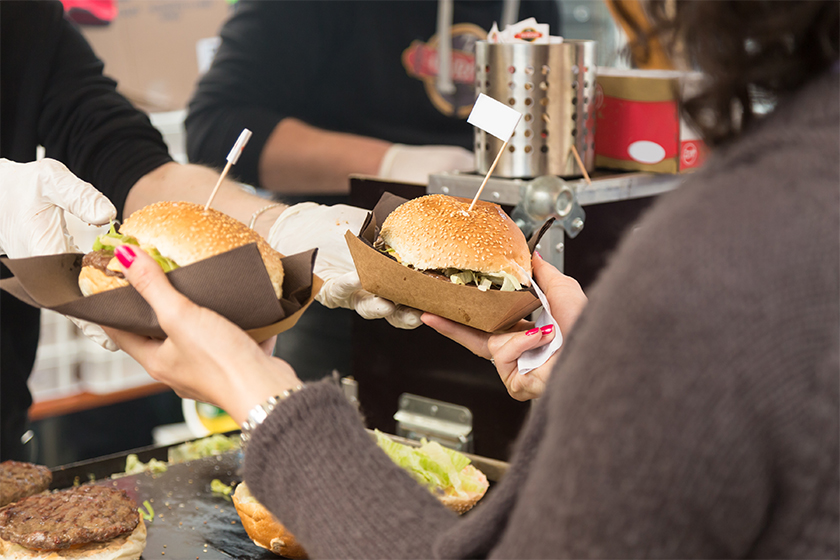“Lunch? You gotta be kidding, lunch is for wimps” – this quote from Michael Douglas’ character Gordon Gekko in the 1987 film Wall Street has since proved to be of its time. Skipping lunch is now for wimps. Workers who skip lunch are less productive, more stressed and more likely to suffer from burn-out than those that take a break in the middle of the day.
Your business should capitalise on the need for workers and students to take a meal break in the middle of the day and make lunchtime a strong part of your business model.
‘Going without food during the working day is never a great idea,’ says Dr Ian Campbell, former chair of the British National Obesity Forum and former honorary clinical director of the charity Weight Concern. Far from boosting efficiency in the workplace, Dr Campbell warns: ‘Because your body starts to go into starvation mode, conserving energy by slowing your metabolism, you feel sluggish. You’re less able to make decisions and more likely to make mistakes.’
Growth in Lunch Trade
Food analysis company Horizons states that in the UK currently around 3.5 billion lunch meals are sold accounting for 44.5% of the foodservice sector. This share has grown 2% since 2012 and is likely to expand by a further 5.6% by 2018.
Emma Read, Horizons’ director of marketing and business development says “Consumers expect to be able to eat when they want, wherever they happen to be , whether it’s out shopping, at work, travelling or in a garden centre,” she says. “Lunch is extending beyond its traditional times – it could now be anything from mid morning to late afternoon. Operators need to be prepared for this and adapt.”

“The growing popularity of street food, particularly in large cities across the UK, continues to offer consumers new food choices. You only have to go to one of London’s busiest street food areas, such as Borough Market, to see the variety of cuisines on offer and how busy they are at lunchtimes.
“Food stalls are selling exciting, innovative food that’s healthy, great value, easy to eat and different. They satisfy consumer’s desire to try something new. These operators are helping to drive lunch of the future,” she adds.
Four Tips on Growing your Lunchtime Business
1: Know your customer base – Survey who your potential customers are in the middle of the day, find out what time major businesses or schools and colleges have a lunch break in your local area. Is your outlet ready to supply them with what they need in the middle of the day? Have lunch specials on offer for students or for office workers, make use of combination meal deals. Have trays of free samples outside busy offices or inside your business. You could even send a free tasting platter to local businesses in order to get your name known and attract customers.
2: Time is Money – While it’s important for workers and students to eat lunch in order to maintain productivity and concentration levels it’s also important that they don’t waste their lunch break queuing and waiting for their food. Make sure your service times during lunch hour are good, many workers will be on a tight schedule and will need to get in and out of your business quickly. You could offer a phone ordering service to ensure food is ready for customers when they drop in. It will also allow the operator to prepare for what menu items are in the greatest demand.
3: Lunch is not Dinner – Remember that customers do not want to spend as much money for lunch as they would for dinner. There should be lower priced deals without sacrificing quality. This means you must tailor the lunch menu for this part of the day. It should be different from your normal evening menu. Have some lower-priced option to go along with offers and meal deals. And do offer smaller, lighter snacking portions – many people don’t like to eat till they’re full at lunch – they want to take the edge off their hunger but to stay mentally and physically alert. Make sure you have a fresh and relevant lunch menu that is particular to that part of the day but also ties in with your main menu – make sure your branding is consistent between all parts of your menu. If you are using a digital menu board make sure you are displaying the lunch menu during that part of the day.
4: Spread the Word – Once you’ve made the adjustments to the menu and have your business primed for an efficient and brisk lunchtime trade you’ve got to use your marketing and advertising skills to increase traffic. Use locally targeted ads to get noticed by local employers. Make contact with clubs and colleges in the area and see if you can provide them with offers for their lunchtime requirements. Of course posting on your social media platforms at the right time will bring attention to your menu. Attractive pictures of your food posted at the right time will make local workers take notice and drive traffic to your outlet.